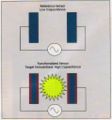Projects/BioSensor
Name: Paola Lira
City: Lima (Peru)
Email: arilyes at yahoo.com
I would like to design a low cost sensor for sensing pathogens and contaminants in food, water and soil. I would develop a permittivity based sensor for real time sensing of pathogens and contaminants. It immobilizes any patogen or contaminant and then the capacitance of a reference sensor and that of target sensor are compared. If the capacitances differ,the patogen or contaminat is present.
Each individual sensor or a group of them can be functionalized for a given specific target: E. coli, Streptococcus, Staphylococcus, Salmonella, Hg, Pb, As.
With the use of mathematical algorithms, the rate of positive events provides data about the concentration of the target pathogem or contaminant.
The sensor will use low costs chips and insumes for sample preparation. The sensor will be connected through USB ports.
Hardware:
- XO
- Arduino Diecimila
- USB A-B
- Wires
- Resistors
Software:
- http://www.arduino.cc/playground/Main/CapSense
- http://blog.makezine.com/archive/2008/01/howto_run_arduino_on_the.html
CONDUCTIVITY MEASUREMENT
The conductivity measurement are applied for determination of various characteristics of agricultural materials and food, for example for determination of the frost sensitiveness, of chilling and freezing tolerance, of moisture content, of seeds germination, of mechanical stress, of pasteurization, of other properties of grains, seeds, meat, sugar, milk, wood, soil, fruit and vegetable, infected food, etc.
DIELECTRIC PROPERTIES MEASUREMENT
The utilization of dielectric properties are applied for example in agricultural materials and food quality sensing: moisture content, maturity of fruit, freshness of eggs, potential insect control in seeds, etc.
Experiments
Soil
Food
Potato Storage
The electrical measurements have carried out on the harvested potatoes on storage facilities and optimum moisture contents for storage will determined. Metal rods have inserted deep into the up most layer and left for continuous measurement. The system measures resistance at 2 points. This provides a more accurate method of moisture content measurement within the potatoes.
I will post updates on my blog http://scitechbizdev.blogspot.com/

